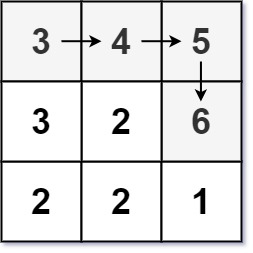Longest increasing path in a matrix
class Solution:
def longestIncreasingPath(self, matrix: List[List[int]]) -> int:
m, n = len(matrix), len(matrix[0])
memo = [[0] * n for _ in range(m)]
def dfs(i, j):
if memo[i][j] != 0:
return memo[i][j]
for drow, dcol in [(1, 0), (0, 1), (-1, 0), (0, -1)]:
nrow, ncol = i + drow, j + dcol
if 0 <= nrow < m and 0 <= ncol < n:
if matrix[nrow][ncol] > matrix[i][j]:
# print((i, j), (nrow, ncol), memo[i][j])
memo[i][j] = max(memo[i][j], dfs(nrow, ncol))
memo[i][j] += 1
return memo[i][j]
res = 0
for i in range(m):
for j in range(n):
# print(memo)
# print(f'start at: {(i, j)}')
res = max(res, dfs(i, j))
# print((i, j), res)
return res
Longest Increasing Path in a Matrix
Given an m x n integers matrix, return the length of the longest increasing path in matrix.
From each cell, you can either move in four directions: left, right, up, or down. You may not move diagonally or move outside the boundary (i.e., wrap-around is not allowed).
Example 1:

Input: matrix = [[9,9,4],[6,6,8],[2,1,1]]
Output: 4
Explanation: The longest increasing path is [1, 2, 6, 9].
Example 2:

Input: matrix = [[3,4,5],[3,2,6],[2,2,1]]
Output: 4
Explanation: The longest increasing path is [3, 4, 5, 6]. Moving diagonally is not allowed.
Example 3:
Input: matrix = [[1]] Output: 1
Constraints:
m == matrix.lengthn == matrix[i].length1 <= m, n <= 2000 <= matrix[i][j] <= 231 - 1
